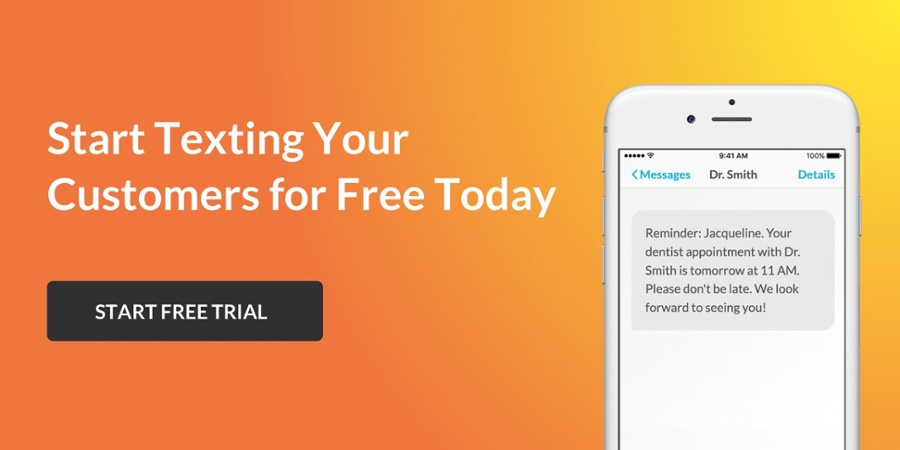When you send your friends or loved ones a text, you generally expect them to respond. Businesses that use SMS marketing tactics, however, don’t always get that same coveted engagement. In fact, business-to-consumer (B2C) response rates are only around 45%—not abysmally low, but there’s definitely room for improvement.
What are SMS response rates? How do businesses calculate them, and what can you do to boost yours? This guide explains this key marketing metric, how to measure it and some effective strategies to get more clients to take you up on your SMS offers.
Table of Contents
Understanding SMS response rate
How to calculate SMS response rate
Factors influencing SMS engagement
How to improve your response rate
Understanding SMS Response Rate
Your business’s response rate isn’t just an ongoing count of how often your clients message you back. A more accurate response rate definition would be: the number of offers your subscribers took you up on compared to the total amount you sent out.
Tracking your brand’s response rate is critical to the success of your SMS marketing campaigns as it offers key insight into consumer behavior. It tells you how far along in the sales funnel they are and how much incentive they need to pull the trigger on a product or service.
For instance, if you receive a high response rate to a relatively timid discount, it may indicate that large numbers of consumers are already strongly considering patronizing your brand. Alternatively, if you receive a comparatively cold response rate to a hot offer, it could tell you that consumers still need a lot of convincing to buy from you.
Response rates are also key to track because they’re one of the few easily calculable figures you can measure for SMS campaigns. Take other key performance indicators (KPIs), for example:
- Total revenue
- Return on investment (ROI)
- Increased number of clients
While these are important metrics to keep tabs on, they’re not as cut-and-dry as your response rate. Revenue, for example, can increase for myriad reasons, and it can be difficult to determine a singular campaign’s effect on the total.
On the other hand, SMS response rate only has two variables to keep track of, and both are easily defined, measured and accessed.
How to Measure SMS Response Rate
As noted, your response rate is how many offers your clients claim versus how many you send out. Thus, the only two figures you need to calculate SMS response rate are:
- Total number of offers redeemed
- Total number of offers delivered
To find your response rate, simply divide the number of offers redeemed by the total delivered. Expressed as a formula, this looks like:
- Response Rate = Total number of offers redeemed / Total number of offers delivered
Say you sent out 10,000 discount codes to your base and 4,500 of them were redeemed. 4,500 / 10,000 = 0.45, or 45%—the average response rate for B2C communications.
With the right data on hand, calculating response rate is easy enough. However, keeping track of how many offers you send to your subscribers and how many subsequently utilize them can be tedious and time-consuming.
To simplify collecting key data on your SMS campaigns, power them with Textedly. Not only does Textedly help you craft more engaging messages that can boost your response rate, but its comprehensive analytical tools provide crucial insight into the performance of your SMS marketing efforts.
Factors Influencing SMS Engagement
There are more reasons for B2C’s 45% SMS response rate than our human tendency to ignore our inboxes. Some major factors influencing this percentage include:
- Message content – Over 270,000 texts are sent out every single second. That’s a lot of content, and if your message isn’t interesting, compelling or worth consumers’ time, it’s likely to be lost in that vast sea of SMS.
- Timing – While the nocturnal amongst us may appreciate a sweet 3 AM coupon code, the vast majority of society will miss a text sent outside their waking hours.
- Frequency – Bombarding your customers’ phones with daily (or hourly) messages is much more likely to annoy them than compel them to explore your brand. Establishing a schedule that doesn’t overwhelm recipients, such as weekly SMS blasts, keeps your business on their minds without becoming a nuisance.
- Audience targeting – The more closely the offers you send out match the needs and desires of their recipients, the more likely they are to be redeemed. Understanding your audience and catering campaigns to their sensibilities is key to bolstering SMS response rates.
Strategies to Improve SMS Response Rate
Speaking of bolstering response rates, digital marketers use a wide variety of strategies and techniques to increase the amount of SMS offers their subscribers redeem. To enhance your business’s response rate, try implementing these practices:
- Amp up your content – Bland, boring and basic messaging won’t make for cutting-edge campaigns. Employ bold, expressive language, interactive content such as polls and giveaways, and similarly savvy SMS marketing tactics to engage more customers.
- Personalize messages – Start with the essentials, like including each customer's name in their text. Then, personalize further by asking about items they recently viewed in your online store, their last purchase, or any other key information you’ve accrued through your data collection efforts.
- Optimize send times – To reach the highest number of consumers when they’re the most active, carefully time when you send your SMS blasts. Generally, the best hours for engagement are weekdays from 9 am to noon, weekends between 10 am and noon and, specifically, Sundays from 4 pm to 7 pm. Tracking individual user’s locations and time zones can help you schedule blasts to reach every subscriber at the optimal hour.
- Segment your audience – Conduct research into your individual customer’s tastes and assign them into groups based on shared preferences. Then, craft tailored messages to reflect the specific interests of your segments by sending them products or offers that are more likely to appeal to them.
Review Response Rate Analytics and Optimize Your SMS Campaigns with Textedly
Calculating your response rate is key to measuring the success of your SMS campaigns. It gives you an insightful glimpse into your customers’ mindsets and tells you how close they are to making a purchase or exploring your brand. Your SMS response rate also tells you how effective your offers are and whether or not you need to tweak them to be more attractive to consumers.
Optimizing response rates takes creative content, impeccable timing and heartfelt personalization. Enhancing SMS campaigns with these features can be a complex task for digital marketers, but Textedly makes it far simpler.
With Textedly, you can easily organize your audience into segments and generate messaging campaigns that appeal to individual users on a personal level. Then, with scheduled SMS blasts, you can reach your subscribers with perfectly timed, custom-catered messages that will capture their attention.
After your subscribers receive their messages, you’ll gain access to key insight about your blasts—including open rate, conversion rate and SMS response rate.
Textedly simplifies and optimizes SMS campaigns for all kinds of businesses. Learn more about our SMS marketing practices and get started toward raising your response rate today.








.png)